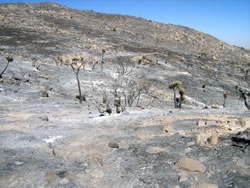
National Fire Plan Success Story
Keys View Fire Rehabilitation
Joshua Tree National Park, California
National Fire Plan - Rehabilitation
2011

The Keys Fire burned in Joshua Tree National Park in August 2010.
In August 2010, a 114–acre fire burned in Joshua Tree National Park adjacent to a popular visitor site called Keys View. Immediately following the blaze, staff from the park’s resource management division assessed damage and initiated a recovery program.
This program includes an herbicide application project for controlling exotic species such as brome grasses that historically germinate and set seed earlier than native species. This early germination produces high fire danger as the temperature increases in late spring and early summer.
With abundant rainfall last fall and winter and an increase of exotic grasses, park fire staff are anticipating a high fire potential and are gearing up for the season.
In addition, National Park Service (NPS) vegetation management crews set up study plots, determined vegetation characteristics and treated the site. Plans call for revisiting these plots to determine which herbicide in each plot was most successful. The crews will also be monitoring any incipient plant populations that may occur within or near the fire.
Vegetation staff is also working with a PhD student at University of California - Riverside to study restoration sites on the Keys Fire. Park vegetation branch chief Josh Hoines states, “We hope to learn from this study how vegetation reacts to fire …and if we can gain a greater understanding of fire in the desert through the restoration process and can share this with a wider community.”
To support these efforts, the park nursery will continue to propagate native species for use in the fire area. During the next several years, crews will plant these natives during the cooler months of fall and spring in the burned area and monitor them to determine success rates. Park staff expects a gradual recovery of native plants during the next three years and are confident the area will fully recover from the fire over time.
Contact: Patrick Pilcher, Park Ranger, (760) 367-5523